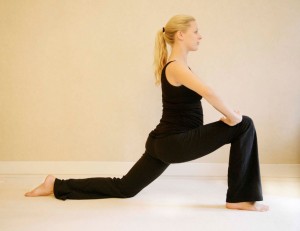Core stretching should take us deep inside to a place at the center of the trunk. For that to happen the stretching should work us towards the core of the body. Often the opposite happens and we are pulled in the directions of our habitual patterns rather than towards our center.
The low lunge or psoas stretch pictured above is a classic stretch that people all over the world are doing on a daily basis whether it be in a yoga class or as a warm up for running or other activity. It is a great example of core stretching and a wonderful way to access your psoas. The question is how is your alignment when you are doing the stretch.
It is my take that we are all splayed open. You will read that sentiment in one form or another all over this blog. The quality of being splayed open pulls a great many parts of the body that should turn or wrap towards the front, towards the back instead. We will consider the IT band in the case of this lunge.
The IT Band, or iliotibial band is a tract of connective tissue that connects the ilium of the pelvis to the tibia of the shin. Its function is to help flex the leg, move the leg out to the side and then turn it in. It also assists the quadriceps to stabilize the knee when walking or running, The IT Band has a little slip of a muscle called the tensor fascia latae (tensor of the outer fascia) embedded within it that helps the tract of connective tissue to accomplish its tasks.
The key to its task for the purpose of this post is internal rotation; if you believe me that we are all splayed open this internal rotator is externally rotating every time we are standing or moving. My main pet peeve is that everyone tucks the pelvis underneath. If your pelvis becomes tucked under for whatever reason, it encourages if not demands external rotation at the top of the thigh.
Lets move to the lunge in the photo. If you have the right foot forward and the left knee on the ground, all the work of the stretch should draw us in to the center of the body. The pelvis in the pose should be neutral with the hips pointing forward equally on both sides. What is going on in the front leg? If the pelvis is pointing straight forward the right knee should be directly in line with the right hip, not pulled even a fraction to the left. The left side of the pelvis should be wrapping forward trying to turn medially as well. Feel the position of the front knee and the opposite hip and you will get a good idea of the natural tone of the IT Band. If the front knee wants to pull outside of the hip and the opposite hip wants to pull towards the back of the body rather than the front this is an indication that tightness in the IT Band is pulling you open.
***

